|
|
The flag of Israel was adopted on October 28, 1948, five months after the establishment of the State of Israel. The symbol in the centre represents the Star of David.
|
|
|
|
|
For millions, September 11, 2001, is a day that will never be forgotten.Image: Visual Capitalist
9/11 timeline: Three hours that changed everything
For Americans and people watching around the world, September 11, 2001, is a day that will never be forgotten.
Within three hours, New York’s tallest buildings were reduced to rubble, and the Pentagon—the nerve center of the American armed forces—was burning and partially collapsed. Thousands of civilians had lost their lives and were seriously injured, and the entire country was in collective shock, still trying to make sense of how a coordinated act of terrorism of that magnitude was allowed to take place on American soil.
In the 20 years since 9/11, the events that occurred that morning have been analyzed in-depth from a thousand different angles. Even though the attacks took place in the era just before mobile phones had viable cameras, there are countless images and videos of the event. As well, we now have the 9/11 Commission Report, which compiles interviews from over 1,200 people in 10 countries, and draws upon two and a half million pages of documents to present its findings.
For many people younger than Generation X, 9/11 is a feeling—a grim milestone from their youth—but the details are likely more fuzzy. The timeline visualization above is a high-level record of what happened that morning during the three hours when everything changed.
A chronology of terror
In its most simple form, the 9/11 attacks can be described as a coordinated hijacking of four commercial airplanes, which were then used to fly into high profile targets in New York City and Washington, DC. Here is a summary of the planes involved in the incident:
There were four planes involved in the crash.Image: Visual Capitalist
These four flights play a central role in what unfolded that morning. In the early hours of September 11, 2001, a collection of 19 would-be hijackers made their way through security at airports in Boston, Newark, and Washington, DC.
Our three-hour timeline begins just before 8am, as the first plane involved in the attack leaves the tarmac just outside of Boston. (In situations where the exact time isn’t known, a range is given.)
Sept 11, 2001, 7:59am – American Airlines Flight 11, a Boeing 767 carrying 81 passengers and 11 crew members, departs from Logan International Airport in Boston, bound for Los Angeles International Airport.
8:14 – United Airlines Flight 175, a Boeing 767, carrying 56 passengers and 9 crew members, departs from Logan International Airport in Boston, bound for Los Angeles International Airport.
8:14 – Flight 11 is hijacked over central Massachusetts. There are five hijackers on board.
8:20 – American Airlines Flight 77, a Boeing 757 with 58 passengers and 6 crew members, departs from Washington Dulles International Airport, for Los Angeles International Airport.
8:42 – United Airlines Flight 93, a Boeing 757 with 37 passengers and 7 crew members, departs from Newark International Airport, bound for San Francisco International Airport.
8:42–8:46 – Flight 175 is hijacked above northwest New Jersey. There are five hijackers on board.
8:46 – Flight 11 crashes into the north face of the North Tower (1 WTC) of the World Trade Center, between floors 93 and 99. All 92 people on board are killed.
8:50–8:54 – Flight 77 is hijacked above southern Ohio. There are five hijackers on board.
9:03 – Flight 175 crashes into the south face of the South Tower (2 WTC) of the World Trade Center, between floors 77 and 85. All 65 people on board are killed.
9:28 – Flight 93 is hijacked above northern Ohio. There are four hijackers on board.
9:37 – Flight 77 crashes into the western side of The Pentagon. All 64 people on board are killed.
9:45 – United States airspace is shut down; all operating aircraft are ordered to land at the nearest airport.
9:59 – The South Tower of the World Trade Center collapses, 56 minutes after the impact of Flight 175.
10:03 – Flight 93 is crashed by its hijackers in a field in Somerset County, Pennsylvania. Later reports indicate that passengers had learned about the World Trade Center and Pentagon crashes and were resisting the hijackers. All 44 people on board are killed in the crash.
10:28 – The North Tower of the World Trade Center collapses, 1 hour and 42 minutes after the impact of Flight 11. The Marriott Hotel at the base of the two towers is also destroyed.
10:50 – Five stories of the western side of the Pentagon collapse due to the fire.
Two and a half hours after the first plane left Boston, the iconic “Twin Towers” lay in ruins in Lower Manhattan, and brave first responders and military personnel were scrambling to save lives and secure the country.
Life in America was set on a new trajectory.
Information shockwave
Two decades is a long time in the world of technology and media. Though the communication channels of that era may seem slow by today’s standards, the September 11 terrorist attacks still took place in the age of 24-hour cable news coverage and nascent online reporting.
Add in the fact that New York was (and still is) a linchpin of global media, and it’s easy to see why media coverage of the attack spread so quickly.
It took media sites minutes to start coverage of the crash.Image: Visual Capitalist
Within two minutes of the first impact on the World Trade Center, a nearby camera crew covering New York’s mayoral primary election was already broadcasting a live feed of the burning building to a TV audience. Within three minutes, news of the attack hit the Associated Press newswire, and moments after that, most major networks cut away from scheduled programming to cover the story.
Less than 10 minutes after the impact, President Bush–who was attending an event at a Florida elementary school–was informed of the crash (which at that point was characterized as an accident).
Because media outlets were able to cover the incident so quickly, millions of people witnessed the second plane striking the South Tower in real-time a mere 17 minutes after the first impact. This was a defining moment as millions of people around the world experience the events precisely as they unfolded.
The still-young internet was strained that day. Moments after the impact of the North Tower, the CNN and MSNBC websites experienced a crushing load of traffic that overwhelmed servers. The FBI’s website also experienced issues after posting the images of the 9/11 hijackers later that day.
|
|
|
|
|
HOLY EQUAL-TO-THE-APOSTLES MARY MAGDALENE
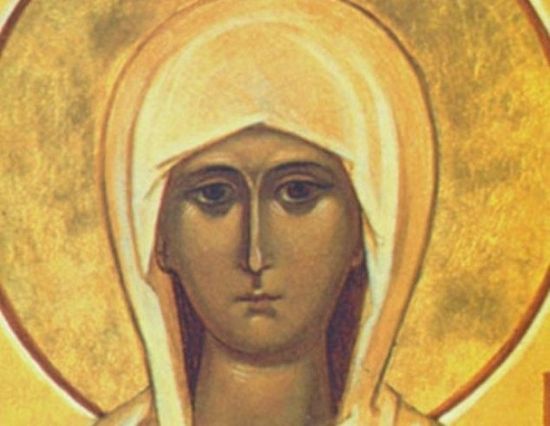
Through His sufferings Christ the Savior redeemed mankind, and opened the gate to the Kingdom of Heaven. During His service he continually preached to all that they follow Him. Those who heard God’s words received them in differing ways, but there were those among them who brought forth fruit in abundance (cf. Mt. 13:8). One of these was the holy equal-to-the-apostles Mary Magdalene. She received that name from the place where she lived, in the town of Magdala. This town belonged to the tribe of Issachar and was located on the western shore of the Sea of Tiberius in Galilee, not far from Capernaum. The naming of a woman for her place of residence shows that she was well-off, because other women’s names were taken, for example, from their family relations: Mary the mother of Jacob, Maria the mother of Cleopas. Luke the Evangelist says that Christ preached the Kingdom of Heaven, and then after Him followed certain women, which had been healed of evil spirits and infirmities, Mary called Magdalene, out of whom went seven devils… and many others, which ministered unto him of their substance (Lk. 8:1–3).
We find the most about Mary Magdalene in the Gospel in passages where the sufferings of Christ the Savior are described, when she showed her dedication and faithfulness to her divine Teacher: Now there stood by the cross of Jesus his mother, and his mother’s sister, Mary the wife of Cleophas, and Mary Magdalene (Jn. 19:25). After the death of the divine Sufferer on the Cross, the centurion on watch believed in the divinity of Christ the Savior. The Evangelist Matthew adds, And many women were there beholding afar off, which followed Jesus from Galilee, ministering unto him: Among which was Mary Magdalene, and Mary the mother of James and Joses, and the mother of Zebedees children (Mt. 27:55–56). Then righteous Joseph of Arimathea asked for the body of the divine Sufferer and buried Him in his own new tomb (Mt. 27–60). As the Evangelist Matthew notes, And there was Mary Magdalene, and the other Mary, sitting over against the sepulcher (Mt. 27:61). The Evangelist Mark says, Mary Magdalene and Mary the mother of Joses beheld where he was laid (Mk. 15:47). Then, when the sabbath was past, Mary Magdalene, and Mary the mother of James, and Salome, had bought sweet spices, that they might come and anoint him (Mk. 16:1). Their worries about the sealed tomb were put to rest all by themselves, when they looked, they saw that the stone was rolled away (Mk. 16:4) and they saw in the tomb a bright angel, who told them the news about the Risen Lord Christ. Then after His resurrection, He appeared first to Mary Magdalene, out of whom he had cast seven devils. And she went and told them that had been with him, as they mourned and wept (Mk. 16:9–10). The Evangelist John the Theologian speaks a little differently and in more detail about the events of those sorrowful days, which would soon become joyful. Mary Magdalene came early, when it was yet dark, unto the sepulchre, and seeth the stone taken away from the sepulcher (Jn. 20:1). She hastened to tell the apostles Peter and John about it, and they in turn hastened to the tomb where they saw the linen clothes lying (Jn. 20:5). Then they returned, but Mary stood without at the sepulchre weeping: and as she wept, she stooped down, and looked into the sepulchre, And seeth two angels in white sitting, the one at the head, and the other at the feet, where the body of Jesus had lain. And they say unto her, Woman, why weepest thou? She saith unto them, Because they have taken away my Lord, and I know not where they have laid him. And when she had thus said, she turned herself back, and saw Jesus standing, and knew not that it was Jesus. Jesus saith unto her, Woman, why weepest thou? whom seekest thou? She, supposing him to be the gardener, saith unto him, Sir, if thou have borne him hence, tell me where thou hast laid him, and I will take him away. Jesus saith unto her, Mary. She turned herself, and saith unto him, Rabboni; which is to say, Master. Jesus saith unto her, Touch me not; for I am not yet ascended to my Father: but go to my brethren, and say unto them, I ascend unto my Father, and your Father; and to my God, and your God. Mary Magdalene came and told the disciples that she had seen the Lord, and that he had spoken these things unto her (Jn. 20:11–18). In the service of the Sunday of the Holy Myrrhbearing Women [the second Sunday after Pascha] we read: “Having come to the tomb seeking the Lord, Mary Magdalene and the other Mary, saw the angel like lightning sitting on the stone, who said to them, ‘Why seek ye the Living among the dead? He has risen as he said. You will find Him in Galilee.”[1]
After the Ascension of the Lord, Mary Magdalene undoubtedly was among certain women (Acts 1:14), who abided in one spirit in prayer with the holy apostles and the Mother of God in the upper room, awaiting the descent of the Holy Spirit. A later traveller describes this place in the holy city of Jerusalem. In the church of Sts. Constantine and Helen, “we were brought … where Christ sat on the stone when He appeared to Maria Magdalene… And the stone, which was the chair, was round, of red rock.”[2] In the church of the Resurrection of Christ “is the stone upon which Christ sat and appeared to Maria Magdalene.”[3]
Church tradition has preserved testimony to her exploits in the capital of the empire. “In Rome, having appeared to the Emperor Tiberius, St. Mary Magdalene brought him a red egg with the words, ‘Christ is Risen!’ Then she told the emperor about the Savior’s sufferings on the Cross. In those days, the presentation of an egg was a sign of joy. From the time of St. Mary Magdalene the trading of eggs on the day of the Resurrection of the Lord amongst Christians became a custom.”[4] This is mentioned in the akathist to the holy Myrrhbearer. In the eleventh ikos we read: “Having reached ancient Rome, courageously didst thou appear before Tiberius Caesar, and with the image of a red egg and wise words thou didst expound to him the life-bearing power of Christ, rebuked deceitful Pilate and the godless high priest, that they will be justly repaid for their lawless deeds… Rejoice, thou who didst not fear Caesar’s wrath; rejoice, thou who didst show him the evil and cunning of Christ’s enemies.”[5] The Church historian Eusebius Pamphilus says that the Roman Emperor Tiberius (14–37) knew from Pilate of the events in Palestine, of the talk about the resurrection of Christ the Savior, “and did not find anything preposterous in Christ’s teachings.”[6] Moreover it is supposed that thanks to Mary Magdalene’s preaching the Roman ruler proposed to the senate that they “include Christ in the pantheon of Roman gods.”[7] The holy Myrrhbearer knew the apostle Paul, whom the Lord had called to preach the Gospel only after His glorious Resurrection, and apparently helped him in his missionary service. Therefore the apostle Paul at the end of his epistle to the Romans writes, Greet Mary, who bestowed much labour on us (Rom. 16:6).
Later Mary Magdalene came to Ephesus, where St. John the Theologian who, as opposed to the other Evangelists, wrote the fourth Gospel significantly later; in it is spoken in detail about the resurrection of Christ the Savior and His appearance to Mary Magdalene. Mary Magdalene reposed in the Lord in Ephesus. St. Dimitry of Rostov (†1709; commemorated October 28), says that she “was laid to rest at the entrance to the cave in which the seven youths of Ephesus would later fall asleep.”[8] In examining the Western version of St. Mary Magdalene’s relics in Provence, Archbishop Sergius (Spassky) notes that “according to the Life of St. Willibald (comm. July 7), bishop of Eichstadt, who travelled to the East in the eighth century, her grave was shown in 745 in Ephesus.”[9] Later her holy relics were translated to Constantinople during the reign of Emperor Leo VI the Philosopher (886–912).[10] Meanwhile Igumen Daniel, who travelled from Kievan Rus’ to the Holy Land at the beginning of the eleventh century, during the heat of the crusades, visited also Ephesus. He wrote, “And here, near that cave where the seven sleeping youths of Ephesus lie, are … also the grave of Magdalene Mary and her head.”[11] And an anonymous Russian traveller who visited Constantinople in the late thirteenth century–early fourth century, that is, after the fall of the Latin empire, describes the holy site in the capital city monastery of Righteous Lazarus: “St. Lazarus the friend of God is sealed in the right column, and his sister Martha lies at his left hand; here … in the left column Mary Magdalene is enclosed.”[12] Later travellers who visited this monastery say nothing about the relics of St. Mary Magdalene.[13]
<…>
The fate of the holy Myrrhbearer’s relics is interesting. Apparently, “during the crusades they were taken to Rome and placed under the altar of the Lateran Cathedral. A part of the relics of St. Mary Magdalene are in France, near Marseille. Particles of her holy relics are preserved in the monasteries of Mt. Athos and Jerusalem.”[14] Many relics of ancient saints, as a consequence of the shameful Fourth Crusade—when in 1204 Constantinople was seized and plundered—ended up in the West. Behind this is the peculiar piety of the Western crusaders. It is worth noting that before and after there were also cases when due to various circumstances the relics of various saints ended up in the West; for example, those of St. Nicholas. An unknown traveller from Suzdal, who went with Metropolitan Isidore in 1438 from Moscow to Italy to the Uniate Council, says of the holy shrines of Venice: “There St. Marko himself lies; and there are many relics of saints, taken from Tsargrad [Constantinople].”[15] Now, centuries later, we can see a special providence in this, because the saints’ relics would have perished from the Turks at the fall of Byzantium.:[16] But during following years the Western Church itself experienced a schism—Protestantism arose, which rejects the veneration of holy relics and icons. Incidentally, the veneration of specific saints in different regions has been preserved and bears a particularly solemn character; for example, in the southern Italian city of Bari they solemnly honor St. Nicholas on May 9: Wearing costumes from the ninth century they carry an ancient sculpture of him through the town, and so forth. In “The Travels of Avraamy of Suzdal to the eighth council with Metropolitan Isidore”, a mystery play is described that was enacted in the Ascension Church of Florence on the very feast of the Ascension. The Mother of God and St. Mary Magdalene were the only female persons named in the play.
Bishop Sergius (Spassky) notes the opinion in Western patristic historiography that equates Mary Magdalene with the sinful woman who washed the feet of Jesus Christ in the house of Simon the Pharisee (Lk. 7:38), as well as the identification of Mary Magdalene with Mary the sister of righteous Lazarus. The Eastern fathers differentiate between them.[17] This is quite an important differentiation in the veneration of the holy Myrrhbearers, because behind it is a different understanding of her life’s path and podvig. Western tradition considers that equal-to-the-apostles Mary Magdalene, after her preaching in Rome, labored in the south of France and Provence, and along with her righteous Martha, Lazarus, and St. Maximinus preached the Gospel. Therefore St. Mary Magdalene is honored as the enlightener of Marseille, who converted its inhabitants to Christianity. The cave, which is preserved in the area of La Sainte Baume, where the holy Myrrhbearer spent time in solitude, later became a place of pious pilgrimage and worship.[18]
In the church of the holy equal-to-the-apostles Mary Magdalene in Saint Maximinus, in the center of the northern part of the basilica there is an entrance to the crypt where the relics of Christ’s disciple were uncovered in 1279.[19] It was discovered that from out of the righteous woman’s mouth a plant was sprouting. Theological thought explained this as a testimony to her special mission: She was an “Apostle to the Apostles”, because it was she who announced the glad tidings of the Resurrection of Christ the Savior to the Apostles.[20] The initiator of the uncovering of the holy relics of Christ’s disciple was Prince Charles of Anjou († 1309), the heir to the duke of Provence. From that time on, Mary Magdalene became the protectress of the Anjou dynasty and of Provence, and her veneration took on a particular, imperial character.[21] A basilica was built over her relics. Here the holy Myrrhbearer is especially honored, and on July 22 according to the Gregorian calendar there are solemnities in the city.
It is important to note the opinion of one Western researcher who “came to the conclusion that the cult of Mary Magdalene arose in Provence no earlier than the mid-eleventh century,”[22] and services to her began in the West “only in the eleventh or twelfth centuries.”[23] They began to write Lives of the holy equal-to-the-apostles Mary Magdalene afterwards: the heremetic edition, the apostolic edition, and then both editions were combined into one. Later her Life was entered into Western hagiographic and homiletic compilations. The co-ascetics and continuers of the labors of St. John Cassian the Roman (†435; comm. February 29) aided in the spread of St. Mary Magdalene’s veneration in Europe.[24]
Because in the West the myrrhbearer was equated with the sinful woman who washed the feet of the Savior with her tears (Lk. 7:38), and the seven devils that tormented her were considered to be “retribution for her sins”,[25] the sermons of the Western clergy glorified St. Mary Magdalene as an example of true repentance.[26] The Eastern tradition, however, considers that these were two different women and that the works of God (Jn. 9:3) were made manifest on her. “Mary Magdalene was possessed by demons not due to her sins or the sins of her parents, but rather it was allowed by God’s Providence in order that the Lord Jesus Christ might show the works of God’s glory, and manifest the great miracle of the healing of Mary Magdalene, the enlightenment of her mind, drawing her to faith in Christ the Savior and to eternal salvation.”[27] Her veneration in the West was multi-faceted. Mary Magdalene’s care for Christ inspired the faithful to good deeds in her name.” Therefore in the Middle Ages guesthouses for travellers appeared that were “under the patronage of St. Mary Magdalene,[28] as well as hospitals and leper colonies. Monasteries were founded in her name, and in fact “monasteries named for St. Mary Magdalene were only outnumbered by those named after the Virgin Mary, which testifies to the great veneration for this saint.”[29] She is also the patron saint of craftsmen of various specializations.[30]
<...>
During life of her Divine Teacher she stood out for her faithfulness and dedication to Him. The later translation of her relics enabled the spread of her veneration in the world. Now, prayers are raised up to her in various countries and Churches. Her name and labors witness to the resurrection Christ the Savior. <...> One preacher said of her: “What a magnificent image of grateful love for the Lord is the holy equal-to-the-apostles Mary Magdalene! And thou, O Christian soul, should like her be penetrated with the same strong and unchanging feeling for the Lord Jesus. By His redeeming service you also are freed in the Sacrament of Baptism, like Magdalene, from the power of the evil, cunning spirits that have nested in you and have had access to people since the time of our forefather’s sin.”[31]
https://orthochristian.com/122857.html |
|
|
|
|
|
FRANKINCENSE/FATIMA/POPE FRANCIS/FRANCE/DA VINCI CODE/FREEMASONRY

And going into the house, they saw the child with Mary his mother, and they fell down and worshiped him. Then, opening their treasures, they offered him gifts, gold and frankincense and myrrh. (Matthew 2:11, ESV)
|
|
|
|
|
|
|
|
La Madeleine
Napoléon Bonaparte is never far from the cultural imagination; he is arguably the most famous French person of all time.
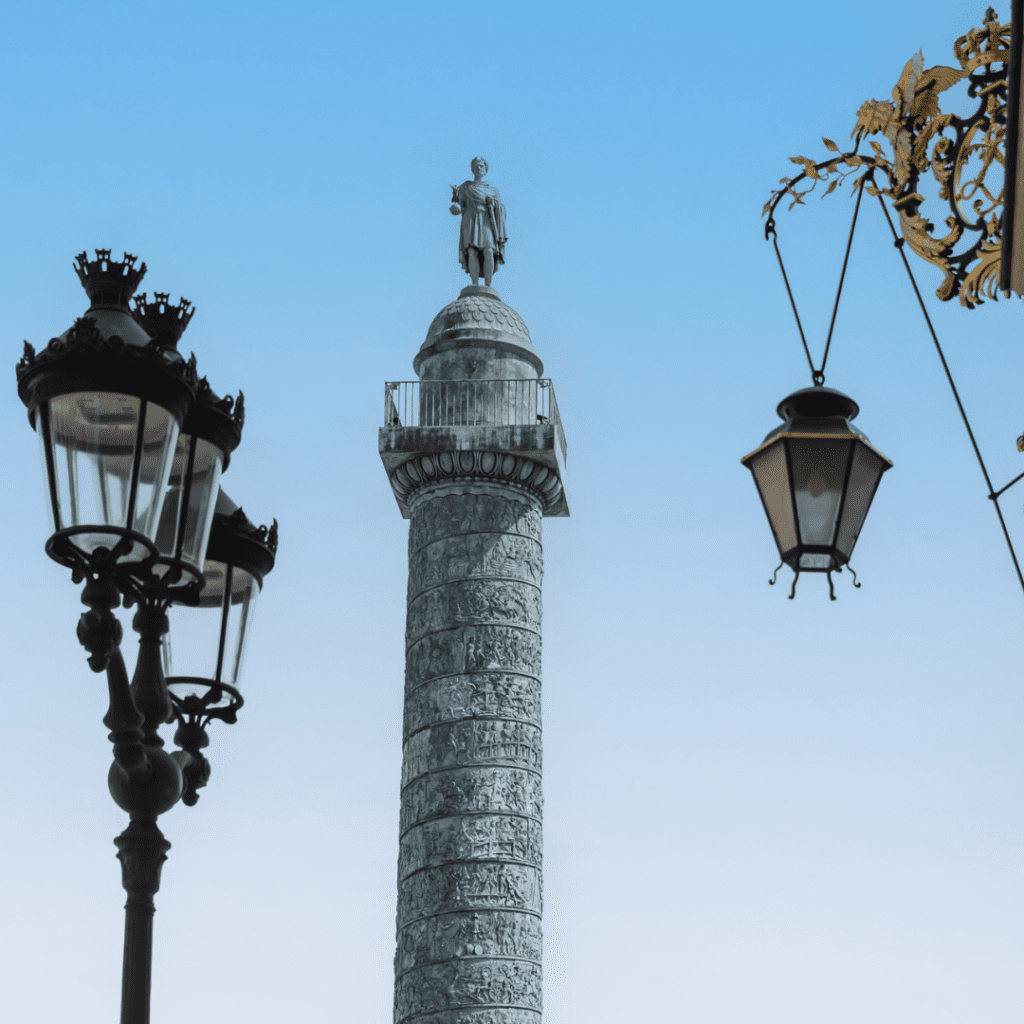 Ph: Manjik/Dreamstime Ph: Manjik/DreamstimeBut the one-time Emperor of France is back in the news in a big way, thanks to the release of Ridley Scott’s Napoleon.
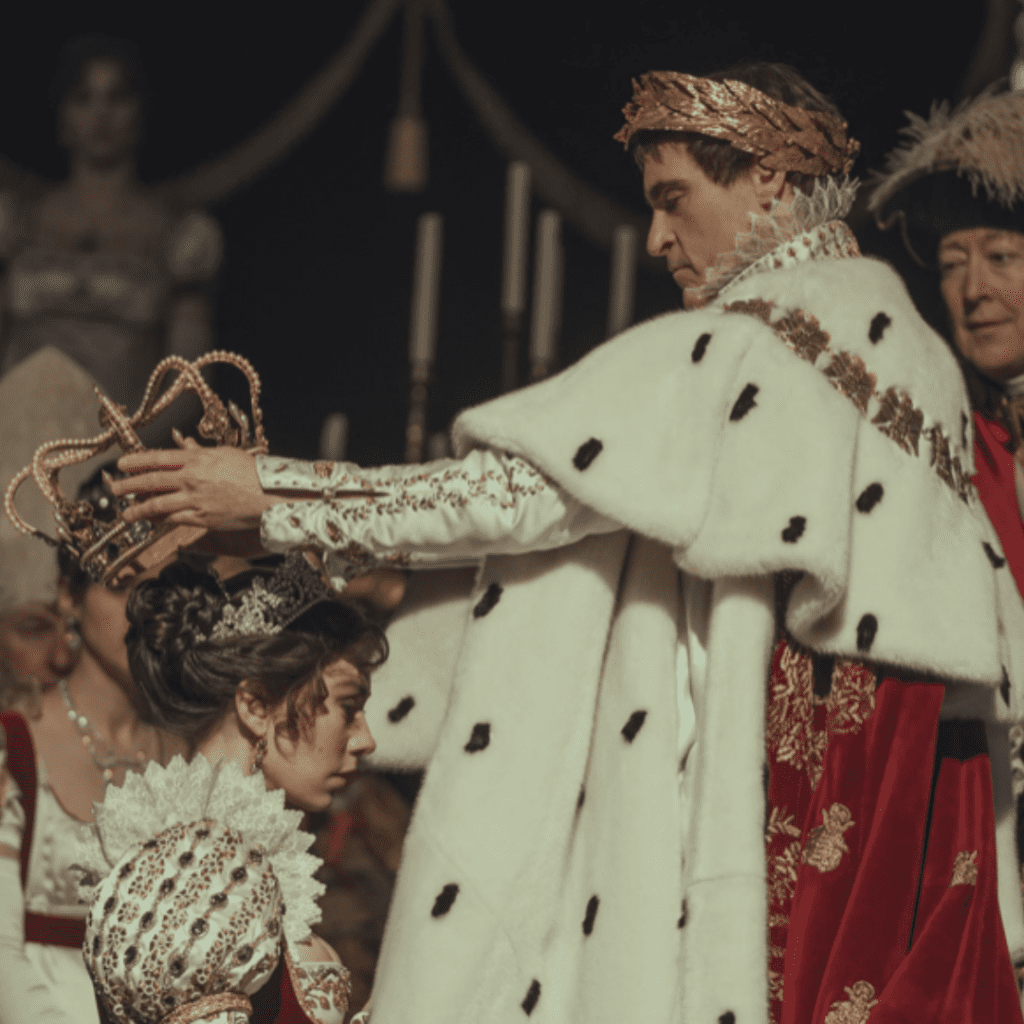 Joaquin Phoenix as Emperor Napoléon crowning Vanessa Kirby’s Joséphine, with Lincoln Cathedral, England, playing the part of Notre-Dame. Joaquin Phoenix as Emperor Napoléon crowning Vanessa Kirby’s Joséphine, with Lincoln Cathedral, England, playing the part of Notre-Dame.While the movie was mostly filmed in England, Malta, and Morocco, you can relive Napoléon’s Parisian days the next time you’re in the City of Light by visiting the monuments he built, and other sites of Napoleonic significance …
Where Napoléon Stayed & Played
Born in Corsica, Napoléon was sent to military school in Champagne at the age of eight. Seven years later, in 1784, he was awarded a scholarship to attend the prestigious École Militaire in Paris (below). The academy, which still operates today, is located at the southern end of the Champ de Mars (the field where young cadets once drilled), behind the Eiffel Tower.
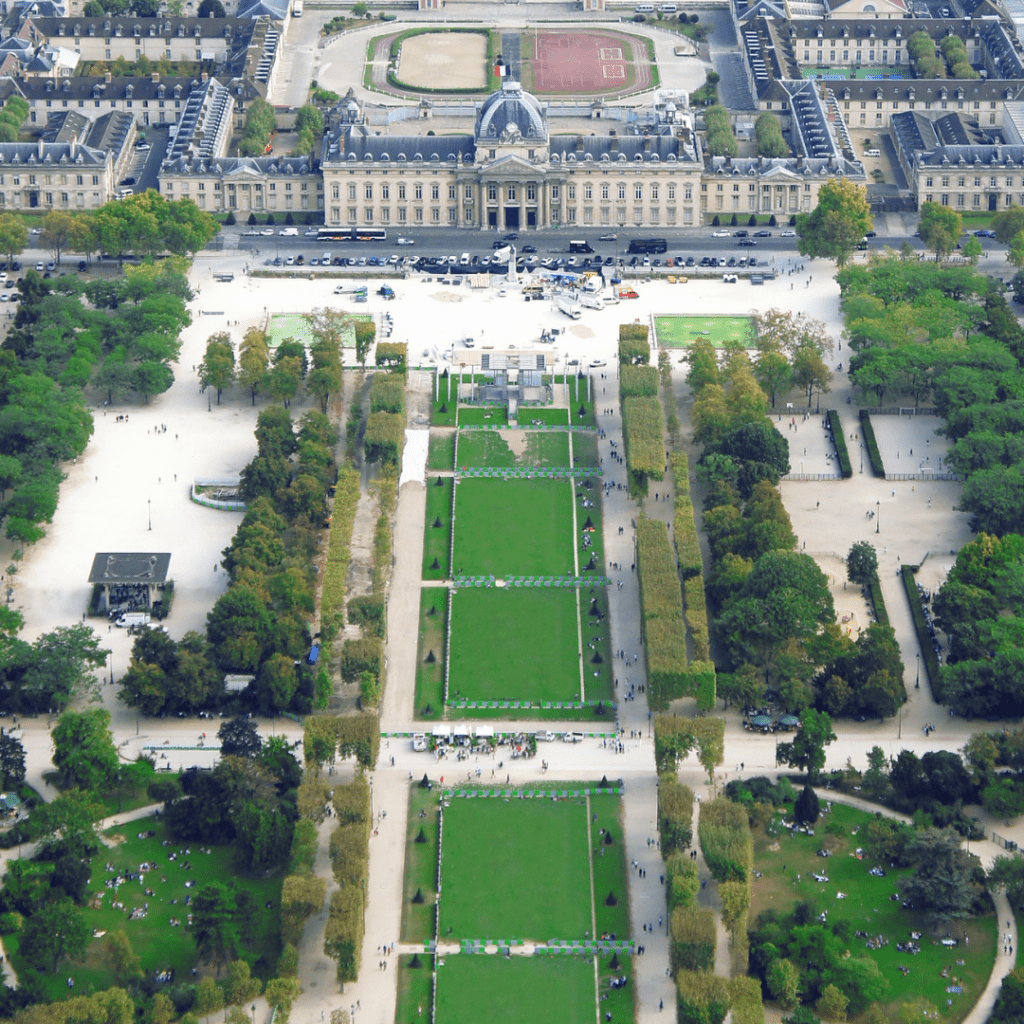 The École Militaire, as seen from the Eiffel Tower. The École Militaire, as seen from the Eiffel Tower.Napoléon’s transfer to Paris involved a two-day journey by boat. He disembarked the Seine at a wharf in the Marais and, as he made his way eastwards to his new school, bought a copy of the novel Gil Blas from a quayside bookseller.
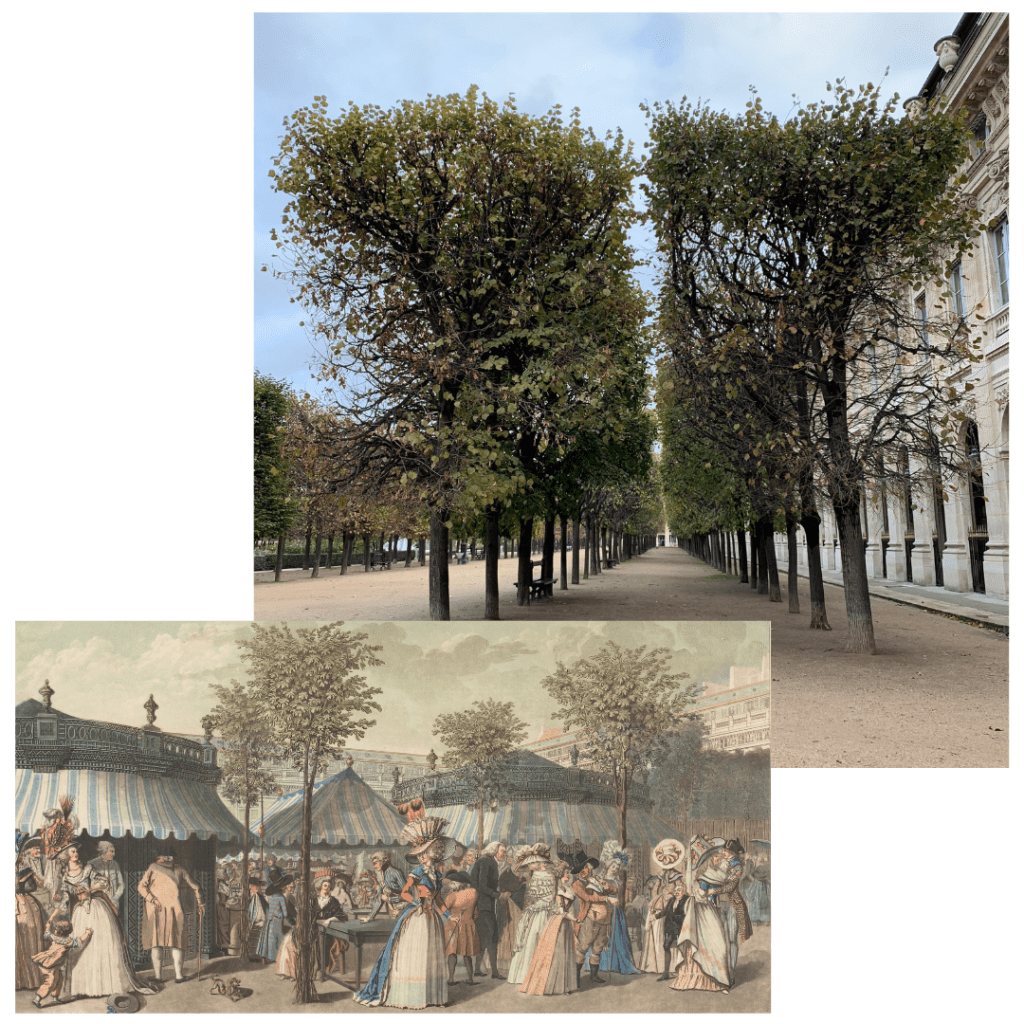 In 1787, after having graduated, a young lieutenant Napoléon found himself back in Paris on leave, and gravitated to the gardens of the Palais-Royal, a notorious party central at the time (above). A cash-strapped Duc d’Orléans Louis-Philippe II had redeveloped his palatial backyard into a pleasure ground in 1784. He had the three wings that frame the northern end of the estate built, renting out the ground spaces as shops and restaurants, while filling the upper floors with dance rooms, gaming dens, billiard halls and brothels. In the middle of the garden enclave there was a circus where acrobatic riders thrilled the crowds, and all sorts of puppet shows and dance performances entertained in the groves of fancifully cut trees. Thousands of Parisians strolled, drank, conversed and flirted in these botanical arcades. The Palais-Royal was a fairground, bazaar and dance party, all in one. It was open day and night, and open to all Parisians — except for police. So you can imagine the air of abandon. Much was lost here. Money — although you could always see the various mortgage agents that had set up shop, or pawnbrokers, to sell your precious gold watch if need be. Virginity, too — a future Emperor Napoléon picked up his first female conquest in this very garden. And lives — Louis Philippe II’s heady vision, inaugurated in 1784, struck him gold, but also eventually cost the duke his head, as he had unwittingly laid the fertile ground for the French Revolution. It was here where courtesans passed as countesses, a precursor of a democratic future France; and where, far from the watchful eyes of the authorities, political discussions could gather momentum, morphing into full-blown movements. The sans-culotte Camille Desmoulins gave a particularly impassioned anti-Royalty speech from atop a table of a café terrace; two days later the Bastille was stormed, and the rest is l’histoire …
Napoléon was often in Paris during the revolutionary years, where the now-Republican networked, wheeled-and-dealed, and generally tried not to lose his head. He was by the old Palais des Tuileries on the day it was stormed by a mob that slaughtered the King’s Swiss guard. Napoléon was savvy in both his political and survival instincts, and ambitious to boot, but surely he can’t have had an inkling that day that this palace (which would be later destroyed by the Paris Commune of 1871) would one day be his imperial home. He did aspire extremely high, however, moving in all the right circles, including A-list parties and salons, where he soon met his fate, in the seductive form of the future Empress Joséphine.
 Napoléon’s professional fate was secured on 5th October 1795, when he was asked to deal with thousands of Royalist soldiers who were making their way down Rue Saint-Honoré, en route to the National Convention, where they hoped to retake power. In front of the Saint-Roch Church (above), Napoléon commanded, inspired, and led his troops so successfully (the cannon-ball damage bears witness to this day) that the young Corsican became an overnight hero. He received an instant promotion and a plush new office on Place Vendôme for his efforts.
In March 1796, after Joséphine finally agreed to a lovesick Napoléon’s marriage proposal, the couple wed in a civil ceremony at 3 Rue d’Antin. (The building is no longer occupied by the 2nd arrondissement mairie but a plaque marks the momentous event). When not away on duty, Napoléon lived with Joséphine on Rue Chantereine (which was soon renamed Rue de la Victoire).
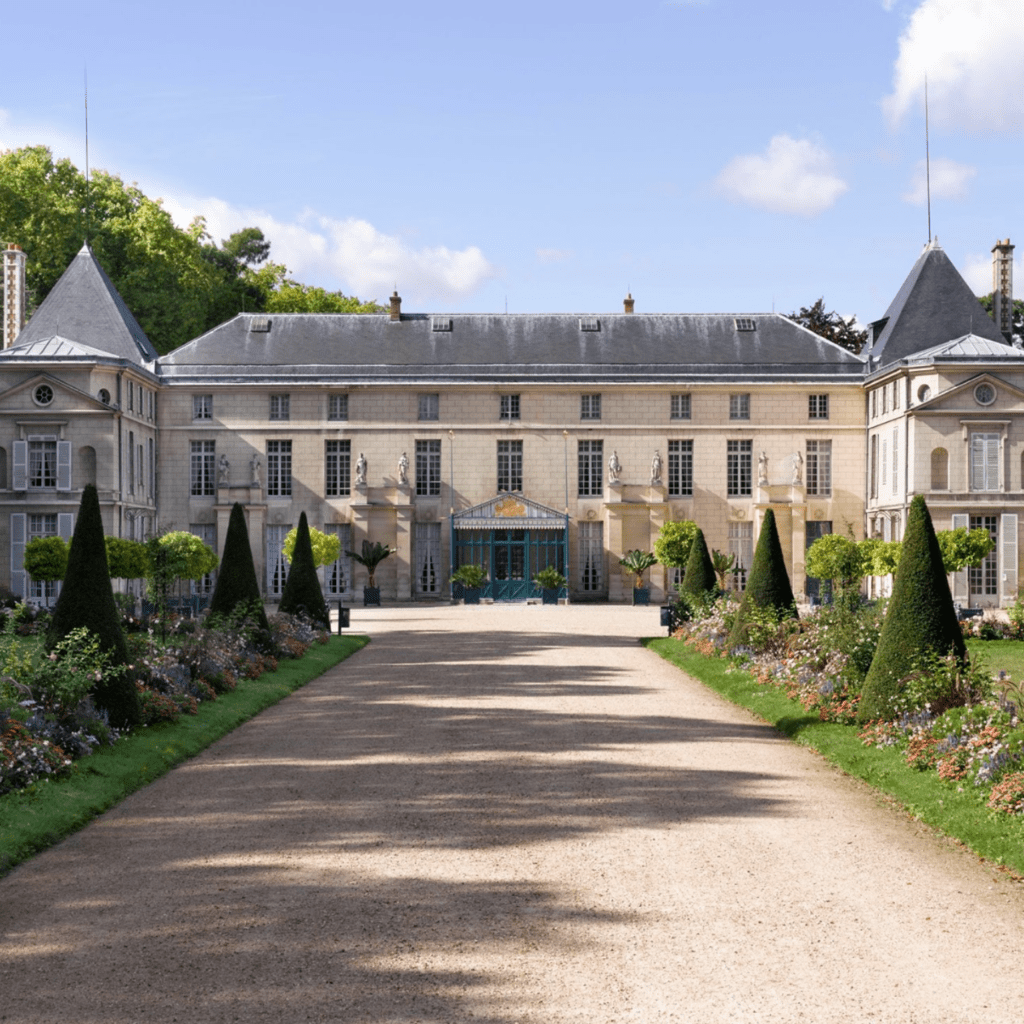 Ph: Courtesy of Chteau de Malmaison. Ph: Courtesy of Chteau de Malmaison.Sadly, her elegant manor house no longer exists, but the lovely country estate just west of Paris that she bought for herself while Napoléon was in Egypt — Chteau de Malmaison — remains in all its neo-Classical glory and is a must-visit for lovers of history, gardens, and architecture.
Napoléon’s Architectural Legacy
A coup d’état of late 1799 — generally considered to mark the end of the French Revolution — saw the overthrow of the Directory leadership of France, and the elevation of Napoléon to the autocratic position of First Consul. The future Emperor (he would crown himself in 1804, in Notre-Dame Cathedral) was now in a position to make his physical mark on his capital.
The neo-Classical trend in architecture had been in favour for a while, but Napoléon, with his passion for arches, columns, and temples, took it to whole new heights, for it represented the fabled grandeur he yearned to project. He wanted Paris to be the new Rome, as befitting a leader who saw himself as a future legend of history. But the aesthetically driven ruler was also engineering-minded, and as such he wanted his city to be cleaner, safer, and more practical. To admire the various changes Napoléon made to Paris, visit the following …
Waterways & Bridges
Napoléon’s utilitarian plan included the construction of new bridges. First up was the Pont des Arts (above), built between 1801 and 1804. The visionary leader demanded it be constructed mostly in iron, which was scarce and expensive at the time, and not considered as chic as limestone, Paris’s classic building block. His vision was perfect; the result was a bridge both modern and elegant, one that has stood the aesthetic test of time. The Pont d’Austerlitz and Pont d’Iéna bridges followed.
 Ph: Janis Smits/Dreamstime Ph: Janis Smits/DreamstimeAs First Consul, Napoléon also ordered the construction of the Canal Saint-Martin (above), Bassin de la Villette (Paris’s largest artificial lake), and Canal de l’Ourcq. Intended to boost the city’s supply of drinking water, this was funded, appropriately enough, by a new tax on wine.
He also cleaned up the banks of the Seine, which were more like strips of beach than true working quays required for the trading needs of a major river city. Up on street level, Napoléon had all roads renumbered, starting from the Seine, with even numbers on the right, odd on the left.
And, to bring drinking water to more Parisians, he decorated those streets with various (often grandiose) fountains, including the Fontaine de la Victoire on Place du Chtelet and the Fontaine du Mars, situated by the now-iconic restaurant of the same name (above).
Rue de Rivoli
As the above examples show, Napoléon’s utilitarian plan could overlap into his ornamental plan for the city. This was also the case with his vision for Rue de Rivoli, for which he turned to his favourite architects, Charles Percier and Pierre-François Fontaine (who had so stunningly redecorated Malmaison in the antique style).
Rue de Rivoli was, originally, a project born of necessity. For one, Napoléon wanted to ease the congested traffic on the nearby Rue Saint-Honoré. But an assassination attempt on him in Rue Saint-Niçaise — one of the narrow medieval streets that once criss-crossed this area, cluttering the approach to the Louvre — also gave Napoléon the impetus for change.
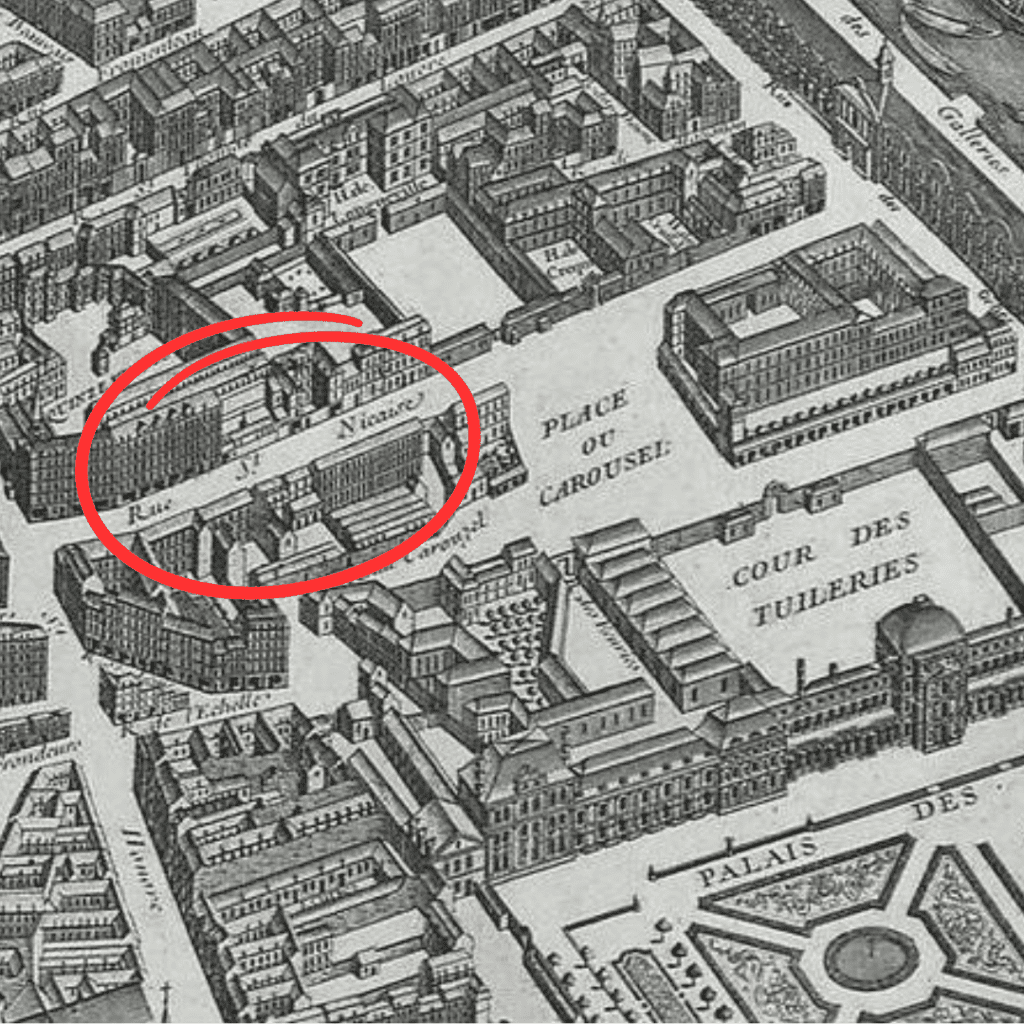 Rue Saint-Niçaise, as seen on the 1730s Turgot Map of Paris. Rue Saint-Niçaise, as seen on the 1730s Turgot Map of Paris.For a little more back-story … on 24th December 1800, Napoléon was in the Palais des Tuileries, waiting for Joséphine and her daughter Hortense who were primping in preparation for a night out at the opera. Napoléon finally gave in to the whims of feminine grooming, and headed out in the first carriage, leaving Joséphine to continue fussing about the best way to wrap on her cashmere shawl. The sartorial delay most likely saved her and Hortense’s lives, for a Royalist-planted gunpowder-filled wagon exploded on Rue Saint-Niçaise just before the second carriage reached its vicinity. Twenty Parisians died in the attack, which also caused major structural damage of nearby buildings. This gave Napoléon both the motivation and excuse for a rebuild; he wanted to clean up the city’s streets, making them safer, wider, and more modern.
While Napoléon’s nephew Emperor Napoléon III, would end up seeing out this city-wide vision (when he hired Baron Haussmann to make over Paris in the mid-century), Napoléon made a great start with Rue de Rivoli (named for one of his Italian victories), which originally stretched from Place de la Concorde to the Place du Palais-Royal. The extensive scope gave Percier and Fontaine a large canvas on which to apply Classical design principles.
 Ph: Engin Korkmaz/Dreamstime. Ph: Engin Korkmaz/Dreamstime.They placed three levels above an arcaded ground floor (the arcades perhaps being inspired by Bologna, which Napoléon had visited in 1796), and minimal decoration beyond shutters and two lines of balconies. (Percier and Fontaine also placed gates opposite the first section of Rue de Rivoli, to line the northern border of the Jardin des Tuileries; they’re still there today.) The seemingly endless perspective projected that Napoléon-adored grandeur, but at the same time, with the continuous arches and curved attic roof (which was added later), the overall effect is charming rather than severe. Rue de Castiglione and Place des Pyramides were also part of the redevelopment, which would go on to influence Haussmann years later.
Colonne Vendôme
Turn from Rue Rivoli into the aforementioned Rue de Castiglione, and you can’t miss the towering verdigris Colonne Vendôme up ahead. The Trajan’s Column-inspired monument was erected in 1806, to replace Place Vendôme’s equestrian statue of Louis XIV, which had been destroyed during the Revolution, and to commemorate the Battle of Austerlitz. Surmounted by a statue of the Emperor, its spiraling bas-relief plates — melted down from 1200 bronze cannons taken from the Russian and Austrian armies — depict Napoléon’s military campaigns.
Arc de Triomphe du Carrousel
The year 1806 — after France’s success at Austerliz — saw Napoléon at the height of his power. He also commissioned this triumphal arch, originally intended as a gate of honour to the Tuileries Palace, as well as a commemoration of his Grande Armée. Fontaine and Percier took inspiration once more from Rome, specifically from the Arch of Constantine. Atop the lovely arch, with its pink-marble Corinthian columns, they placed the horses of St Mark’s in Venice, which Napoléon had taken as a souvenir of his conquest of that city. The current horses are replicas, after the originals were returned in 1815 (along with much other stolen artwork).
Arc de Triomphe
In the same year, Napoléon commissioned this much larger arch, also in commemoration of his army, on the site of the old city gates. At the time, the Avenue des Champs-Élysées was little more than a country road on the outskirts of Paris. Since the destruction of the Palais des Tuileries, the Arc de Triomphe can be viewed from its little sister arch — they’re two bookends of a world-famous vista. The larger arch’s distance from the palace dictated its majestic size, for it needed to be admired from afar. Sadly, Napoléon didn’t get to see this particular dream materialise; the monument required several decades to reach completion. His ghost, however, would surely be happy that it is now a symbol of French pride and a focus of many civic celebrations, with the Flame of Remembrance burning brightly by the tomb of the Unknown Soldier.
Église de la Madeleine
Napoléon, in 1806, also announced that the part-built church on this site would be redesigned and repurposed as a temple to the glory of the French army. Cue a rectangular Greco-Roman-style temple with a peristyle of Corinthian columns, styled à la Rome’s Pantheon. View it from the start of Rue Royale, then turn around to locate its twin monument on the other side of the river from Place de la Concorde; Napoléon had this Roman portico façade added to an old palace, Palais Bourbon, to reflect and amplify the overall effect of Classical grandeur on Place de la Concorde. That latter building is now the National Assembly, while the Madeleine has been a church since it was, finally, completed in 1842.
Musée du Louvre
The Louvre — the royal court until Louis XIV moved out to Versailles — found new life as a museum in 1793, which is rather astonishing because this was during some of most the tumultuous days of the Revolution. But it makes sense in the context of liberté and égalité, for it was, among other things, a way to share with everyday French citizens something that had, until now, been exclusive to high society.
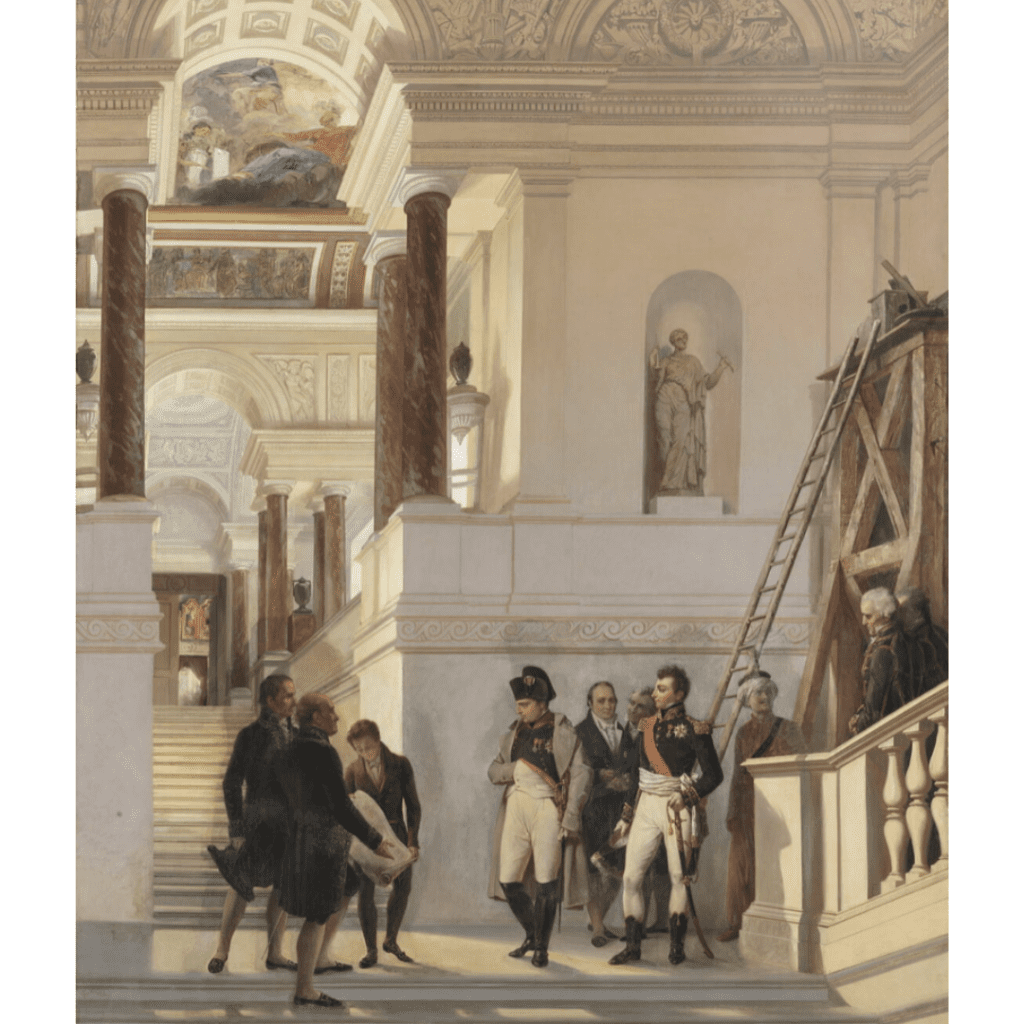 Napoléon inspecting the works of Percier and Fontaine, painted by Auguste Couder. Napoléon inspecting the works of Percier and Fontaine, painted by Auguste Couder.Napoléon continued this mission of the Louvre as a place of art and beauty for all — also, he needed somewhere to store all of the art he had stolen on his various campaigns! (Like the horses atop the Arc de Triomphe du Carrousel, most would eventually be returned to rightful owners; Veronese’s glorious Wedding Feast at Cana is one that remained at the Louvre.) Napoléon also decreed that it was high time to restore a neglected Louvre, and complete it with a northern wing — which was now an easier job, thanks to the various demolitions that followed the Rue Saint-Niçaise bombing attempt.
 Ph: Konstik/Dreamstime Ph: Konstik/DreamstimeSo Percier and Fontaine got to work on beautifying the Louvre in numerous ways, including completing the lovely Cour Carrée. (Much of their interior design no longer exists, but walk through the Salles Percier and Fontaine to admire their gorgeous Empire style.) They were in the midst of constructing the Louvre’s northern wing, which now houses the Musée des Arts Décoratifs (above), when Napoléon was defeated at Waterloo, necessitating a putting-down of tools. The Louvre would finally be completed during the reign of Napoléon’s nephew … although poignantly, the Tuileries Palace, which by now served as the western wing of the complex, burnt down the year after Napoléon III’s abdication.
Also Not-to-Miss for Napoléon Fans …
Debauve & Gallais (30 Rue des Saints-Pères, 75007) is the most historically significant chocolaterie in town, with a classified interior that dates back to its 1817 opening and was designed, no less, by Napoléon’s beloved Percier and Fontaine.
Le Procope (13 Rue de l’Ancienne Comédie, 75006), now a restaurant that serves classic Gallic fare in a glittering olde-worlde setting, was originally — from 1686 — one of Paris’s first cafés, and served coffee along with an inspiring ambience to its philosophically-minded clientele. As the Revolution brewed, the crowds became more politically activist; the now-national motto ‘Liberté, Égalité, Fraternité,’ is said to have been coined here. Napoléon, as an up-and-coming mover and shaker, was by this time a customer, albeit a poor one … One of his famous bicorne hats is on display in a glass cabinet (above), said to have been left here one day by the man himself, in lieu of paying his bill with money.
Le Grand Véfour (17 Rue de Beaujolais, 75001). When Napoléon finally did have money, this jewel box of a restaurant was a favoured dining spot of the imperial couple.
 Ph: Mkojot/Dreamstime Ph: Mkojot/DreamstimeWhile Napoléon’s downfall was brutal, his exile punishing, and his death lonely, his remains made a triumphant return to Paris in 1840. Watched by thousands of Parisians (who had fallen back in love with their former Emperor once more), the horse-drawn hearse made its way from the Arc de Triomphe (which had finally been completed in 1836) down to Place de la Concorde, and then over to Les Invalides, where his tomb still rests under the gilded dome; to visit, buy a ticket to the Musée de l’Armée.
https://parisfordreamers.com/tag/la-madeleine/ |
|
|
|
|

Star of David
based on a Hebrew video by Oren Evron here  The Star of David is an ancient symbol of Judaism (see Drashot Ben Ish Chai, ki teitzei). The oldest complete manuscript of the Hebrew Bible, known as the Leningrad Codex (dated 1008CE), has a "Star of David" on its cover page. 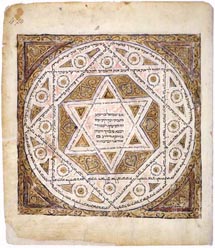 Is there a sign that the Hebrew word "Yisrael" ( ישראל) and the "Star of David" figurate are mathematically connected? The mathematical formula for "Star of David" (Hexagram) figurate numbers is Star(n) = 6n(n-1)+1 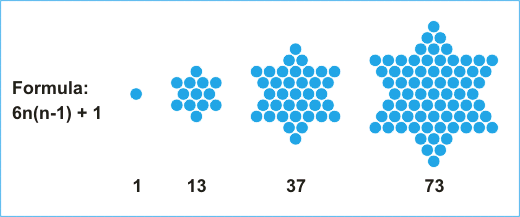 The Star of David (Hexagram) figurate is formed by the merging of two triangle Figurates. For example, two 28 dot triangle figurates can be merged to form a 37 Star of David figurate. 
Triangular Numbers
A pool game, for example, is made up of 15 identical size billiard balls.  15 is a triangular number. Thus, the 15 balls can be arranged into a perfect triangle figurate. If there were 14 balls or 16 balls, this would not be possible. Examples of triangular numbers are 3, 6, 10, 15, 21, 28, 36, 45, etc. Their mathematical formula is: Triangle(n) = n(n+1)/2  Let us now look at the Star of David (Hexagram) numbers according to their formula:
Star(n) = 6n(n-1)+1
| 1 |
6×1(1-1)+1 |
= |
1 |
| 2 |
6×2(2-1)+1 |
= |
13 |
| 3 |
6×3(3-1)+1 |
= |
37 |
| 4 |
6×4(4-1)+1 |
= |
73 |
| 5 |
6×5(5-1)+1 |
= |
121 |
| 6 |
6×6(6-1)+1 |
= |
181 |
| 7 |
6×7(7-1)+1 |
= |
253 |
| 8 |
6×8(8-1)+1 |
= |
337 |
| 9 |
6×9(9-1)+1 |
= |
433 |
| 10 |
6×10(10-1)+1 |
= |
541 |
| .. |
.. |
|
.. |
All these numbers are and always will be beautiful Star of David numbers.  Let us now look at the Hebrew word "Yisrael" ( ישראל).
| Gematria of Yisrael |
| ל |
א |
ר |
ש |
י |
| 30 |
1 |
200 |
300 |
10 |
| Total=541 |
Our name "Yisrael" stems from the Torah:
"G-d said to him, 'your name is Yaakov. Your name shall no longer be called Yaakov, but Yisrael shall be your name', and He named him Yisrael" (Gen.35:10).
G-d Himself granted us this name after Yaakov, our forefather, vanquished the angel of Eisav which he (spiritually) wrestled with (Genesis 32:23-31). This angel was the Satan himself.
| Satan |
= |
שטן |
= |
359 |
|
| Yaakov |
= |
יעקב |
= |
+182 |
|
| Yisrael |
= |
ישראל |
= |
541 |
Total |
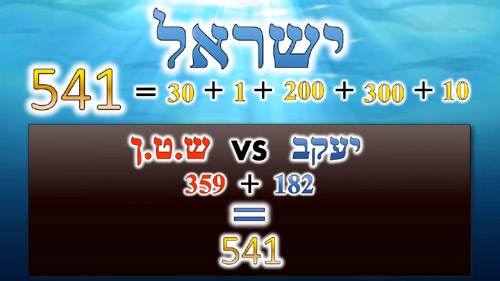 Yaakov won the struggle and transformed the power of evil to the power of good and this joined with his old name to grant him the new name - Yisrael. Do you recognize the number 541? It is none other than the 10th Star of David number.  It is interesting that Yaakov received the name Yisrael after defeating the Satan. Yisrael hints to a perfect/whole man - Tiferet Yisrael (the splendor of Yisrael).
| Center Point |
541 is the exact center point of 1081
| 1--------------------1081 |
^
541 |
Tiferet (תפארת) = 1081 and Yisrael ישראל = 541
|
For Yaakov, the man of truth (Michah 7:20), had all his 10 Sefirot rectified properly (he also became a Merkava (chariot) for the Sefirah of Tiferet). 10 is a whole/collective number. Thus, G-d created the world with 10 utterances and gave us the 10 commandments. This is why the name G-d granted to us after Yaakov defeated the power of evil is the 10th star of David number. The statistical odds of the Hebrew name Yisrael having gematria of 541 are slightly more than 1 percent (see video). Thus, the chance of this being designed is about 99 percent. There is much to elaborate on this. For example, the inner hexagon of Yisrael has 271 dots.  The 12 triangles in the Magen David have 45 dots (Gematria of Adam). 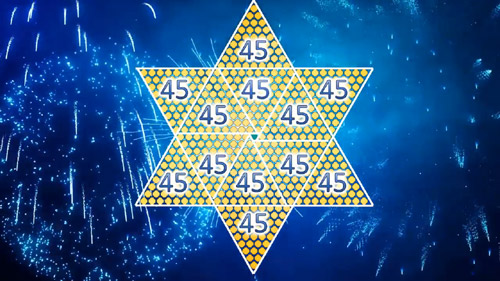 Every diagonal has 37 rows, and much much more.  Interestingly, 541 = 100th prime number = 10 2
Snowflakes
One of the most striking examples of natural artistry in the inanimate world is in the formation of snowflakes. Each snowflake is a miracle of beauty, a masterpiece of design and no one design seems to ever be repeated. Amazingly, snowflakes typically have a Magen David or an outline of it discernible in the center. Here is a picture of a real typical snowflake under a microscope. 
Zion Star
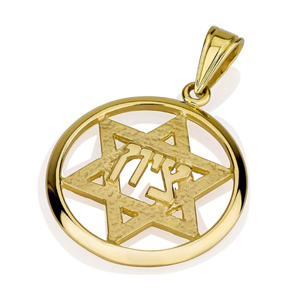 The Torah commands us: "speak to all the congregation of the people of Israel and say to them, you shall be holy, for I the L-rd your G-d am holy." (Lev.19:2). The final verse in this weekly portion (Kedoshim) has 2701 Gematria [1]. For this torah portion contains the purpose of creation - to become holy like G-d. "And they shall make Me a sanctuary and I will dwell in their midst" (Ex.25:8). And in the "Path of the Just" ch.26 (final chapter):
"But for the holy man who constantly clings to his G-d, whose soul treads freely among true thoughts in love of his Creator and fear of Him, behold, it is considered as if he is walking before G-d in the Land of the Living, while still here in this world.
Such a man is himself considered as a Tabernacle, a Temple and an altar. For the Shechina (divine presence) dwells within him just as it dwelled in the Temple [of Jerusalem]. Due to this, the food he eats is like a sacrifice offered upon the fire of the altar, for certainly it was a great elevation for those things to be offered on the altar, since they were offered before the Shechinah."
Amazingly:
| The Gematria of "Zion", the place of the Temple: |
| = |
ציון (Zion) |
= |
156 |
| The Gematria of "Shechina" (divine presence): |
| = |
שכינה (Shechina) |
= |
385 |
| Total: 156 + 385 = 541 (Israel) |
 The 10th Star of David figurate (Israel) is composed of a frame and inner part. Amazingly, this splits into 156/385 for Zion/Shechinah. And in the daily prayers, we say: "And may our eyes behold Your return to Zion in mercy. Blessed are You L-rd, who restores His Shechinah to Zion" 156 is also the Gematria of "Yosef" who was the epitome of the "Tzadik" (righteous person) [2]. For as before, the job of the Tzadik is to become a Temple for G-d's holiness just like Zion was the Temple for G-d's Shechina (divine presence [3]) (heard from Oren Evron).  Interestingly, the "Zionist" movement to resettle the land of Israel consisted mainly of secular Jews. For they wanted the land of Israel as a sort of nationalist motive. But their motives lacked the Shechinah aspect. Thus, divine providence arranged it that the Israeli flag of the "Zionists" was that of the frame of the star of David only. But the real purpose of Israel is to also bring the Shechinah into the world. (and likewise, for marriage between husband and wife - to build a torah home where the Shechinah can dwell. All this and more is symbolized in the Star of David!) >> Next: Divine Star
https://www.dafyomi.co.il/general/info/torahau/torah_numerology.php?d=19
|
|
|
 Primer Primer
 Anterior
9 a 23 de 23
Siguiente Anterior
9 a 23 de 23
Siguiente
 Último
Último

|

